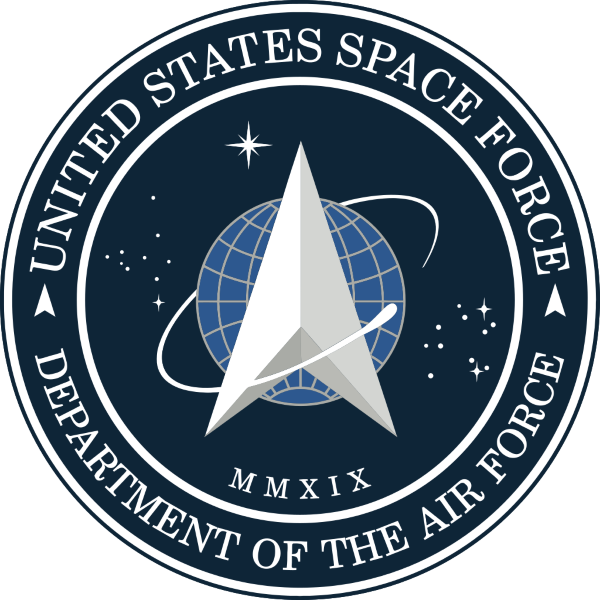The United States Space Force is the sixth and newest branch of the U.S. military.
Space Force members are called guardians, and they are responsible for facilitating global space exploration operations as well as protecting and defending American interests in space.
Organized under the Department of the Air Force, the Space Force’s ranks are similar in structure to Air Force rankings.
Here is a comprehensive explanation of Space Force ranks, both enlisted and officer.
Related Article – How To Join The Space Force
Table of Contents
What is the United States Space Force?
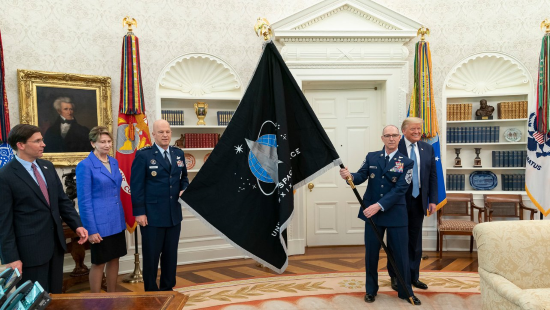
The United States Space Force (USSF) is the newest branch of the American Armed Services.
It is organized under the Department of the Air Force, in a similar manner as the Marine Corps is organized under the Department of the Navy.
Part of the USSF mission is to organize, train, and equip Guardians (Space Force members) to conduct global space operations, enhance the way joint and coalition forces fight, and offer military options to achieve national objectives.
When Was The Space Force Founded?
The U.S. Space Force was founded with the National Defense Authorization Act, signed into law by former president Donald Trump on December 20, 2019.
This established, with bi-partisan support, the first new armed services branch in over 70 years.
The founding of the USSF resulted from agreement that there is a need for American military service to specifically protect national security and pursue superiority in the domain of space.
Space Force Ranking Structure
The official Space Force rank structure was announced on January 29, 2021.
Eight months later, official insignia’s for each guardian rank were released.
Each rank and insignia represents the level of responsibility and seniority that individual holds in addition to their pay grade.
The USSF is the only branch of the armed services that doesn’t recruit members from basic training.
Instead, the Space Force acquires its guardians from the space systems operations career field of the U.S. Air Force.
Enlisted and officer ranks of the USSF are explained as follows.
Related Article – Air Force Ranks & Basic Pay
Specialist Ranks: E1-E4
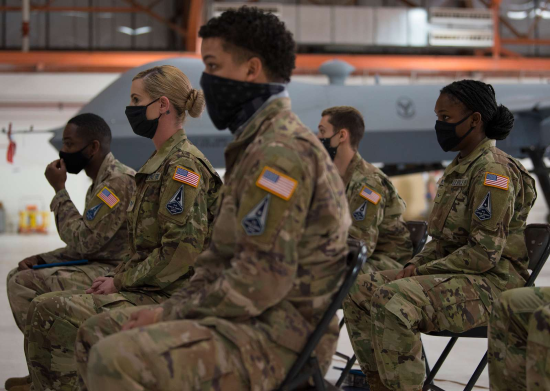
All Space Force members must graduate from Air Force basic training.
Air Force members that transition to the Space Force begin with the rank of specialist.
- Specialist One (E-1/Spc1): This is the initial, base rank assigned to guardians when they transition into the Space Force.

- Specialist Two (E-2/Spc2): This is an automatic promotion from E-1 if service and behavior requirements are met. Guardians with Spc2 rank are required to undergo training for space systems operations after basic training.
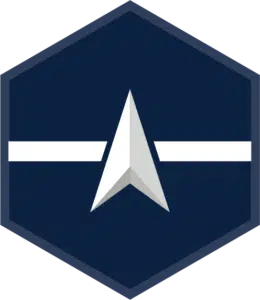
- Specialist Three (E-3/Spc3): This is a promotion from E-2 and Spc3 guardians are expected to perform regular job duties as well as refine their space systems operations skills.
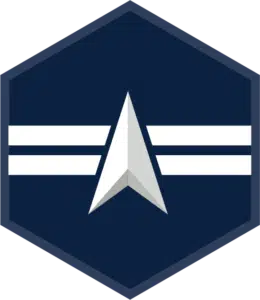
- Specialist Four (E-4/Spc4): Promotion to E-4 is considered a transitional level at which guardians are expected to set leadership and behavioral standards as well as continue their education.
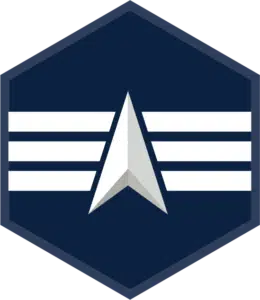
Noncommissioned Officers: E5-E6
The Space Force ranks of E-5 and E-6 are considered non-commissioned officers, otherwise known as NCOs.
However, at this ranking level, promotions are not automatic.
Therefore, guardians must compete for promotions based on the Weighted Airman Promotion System (WAPS).
Here are the factors that determine NCO eligibility for promotion:
- Time in service
- Time in pay-grade
- Skill level
- Commander recommendations
- WAPS points
WAPS promotion points can be earned with the following:
- Medals
- Awards
- Positive performance evaluations
- Promotion fitness exam
- Specialty knowledge test
Guardians with the highest WAPS points earned are promoted first.
Sergeant (E-5/Sgt)
Sergeant is the first NCO rank in the USSF.
In addition to their leadership roles and job duties, sergeants must hold a level 5 (journeyman) or level 7 (craftsman) of skill.
They are also expected to expand their knowledge and skills as supervisors and technicians.
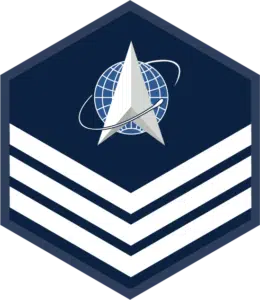
Technical Sergeant (E-6/TSgt)
Sergeants can earn the promotion of technical sergeant, the second NCO rank in the Space Force.
Technical sergeants hold supervision as well as challenging technical duties.
They are also leaders for the career development of their subordinates, making sure effective tools and training are provided.
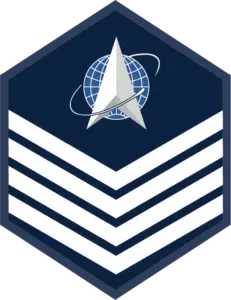
Senior Noncommissioned Officers (E7-E9)
Senior noncommissioned officers (SNCOs) in the Space Force hold the ranks of E-7, E-8, and E-9.
These ranks are earned by skill level.
For example, E-7 guardians must have a 7-level (supervisor) skill level, and E-8 guardians and above must have a 9-level (manager) skill level.
- Master Sergeant (E-7/MSgt): In addition to leadership responsibilities, master sergeants must possess full knowledge of the technical skills involved in their positions.
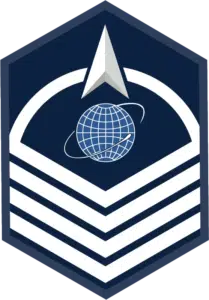
- Senior Master Sergeant (E-8/SMSgt): Senior master sergeants must have 15 to 30 years of service and demonstrate supervisory leadership to subordinates. This rank is very competitive, as just 2% of enlisted guardians can be promoted to SMSgt by the central promotion board which reviews and evaluates service records for professionalism, experience, leadership, performance, education, and more.
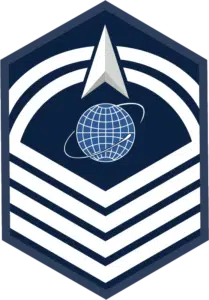
- Chief Master Sergeant (E-9/CMSgt): Chief master sergeants assume the roles and responsibilities of leaders, managers, and advisers. Just 1% of enlisted guardians can hold the rank of CMSgt. Command chief master sergeants advise base commanders and provide communication and information that may impact command mission and operations.
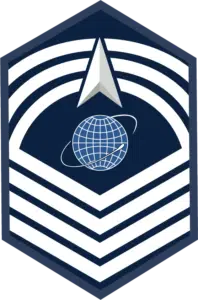
Related Article – Commissioned Officer vs. Non-Commissioned Officer (NCO)
Chief Master Sergeant of the Space Force (CMSSF)
Chief Master Sergeant of the Space Force is the highest level rank a guardian can hold.
This distinct individual advises and reports to the Chief of Staff and Secretary of the U.S. Space Force.
Therefore, the CMSSF must represent the enlisted members of the USSF, providing leadership and guidance for the entire corps of enlisted members.
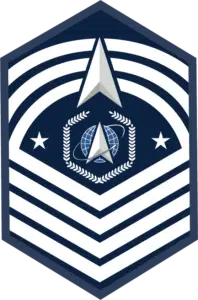
Commissioned Officers
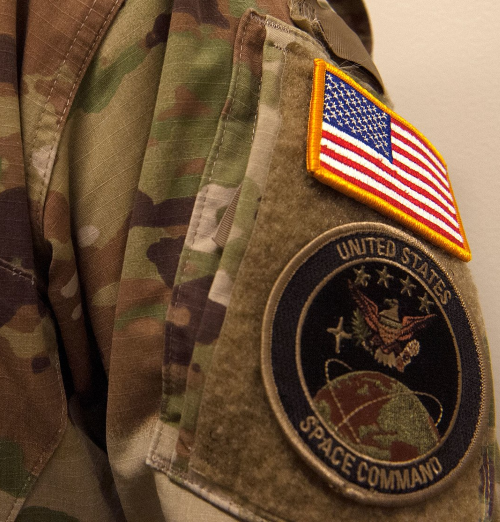
The USSF is also comprised of commissioned officers (Cos) as well as enlisted members.
These include officers at the following levels:
- Company grade
- Field grade
- General officers
Company-Grade Officers (O-1 to O-3)
- Second Lieutenant (O-1/2d Lt): Second lieutenants are new commissioned officers and generally receive training in various areas.
- First Lieutenant (O-2/1st Lt): First lieutenants are promoted from second lieutenant rank. They have similar jobs and responsibilities but additional experience and training.
- Captain (O-3/Capt): Captains provide leadership and direction to junior officers and enlisted members within their unit. It typically takes about 4 years to be promoted to O-3.
Field-Grade Officers (O-4 to O-6)
- Major (O-4/Maj): Majors often work at the squadron or wing level and sometimes may serve as the squad commander. This rank entails administrative and managerial as well as leadership responsibilities. In addition, majors must pursue further education to attain a master’s degree or higher.
- Lieutenant Colonel (O-5/Lt Col): Lieutenant colonels are often required to take command positions in addition to assisting colonels. Lieutenant colonels also serve as mentors to junior commissioned officers.
- Colonel (O-6/Col): As the highest ranking field-grade officers, colonels hold graduate degrees and take responsibility for thousands of service members on base, improving productivity, services, and mission readiness. Colonels also lead USSF training schools.
General Officers (O-7 to O-10)
- Brigadier General (O-7/Brig Gen): Brigadier generals are often in command of bases or serve as high-level staff leaders at the Pentagon or within other organizations. This rank entails a great deal of administrative and leadership duties.
- Major General (O-8/Maj Gen): Major generals typically hold positions as high-level leaders and may be responsible for about 10,000 Space Force members. Major generals often serve as joint force commanders as well.
- Lieutenant General (O-9/Lt Gen): Lieutenant generals typically hold command at major bases and/or posts. They serve as overall leaders for members of USSF.
- General (O-10/Gen): General is the highest rank anyone can earn in the U.S. Space Force. Those who achieve this rank hold positions in the Pentagon and other organizations at the highest levels.
- Ikon Pass Military Discount: Learn How To Save Big - January 31, 2025
- RTIC Military Discount: Find Out How To Save Big on Gear - January 30, 2025
- Traeger Military Discount: Learn How To Save Big on Smokers - January 28, 2025

